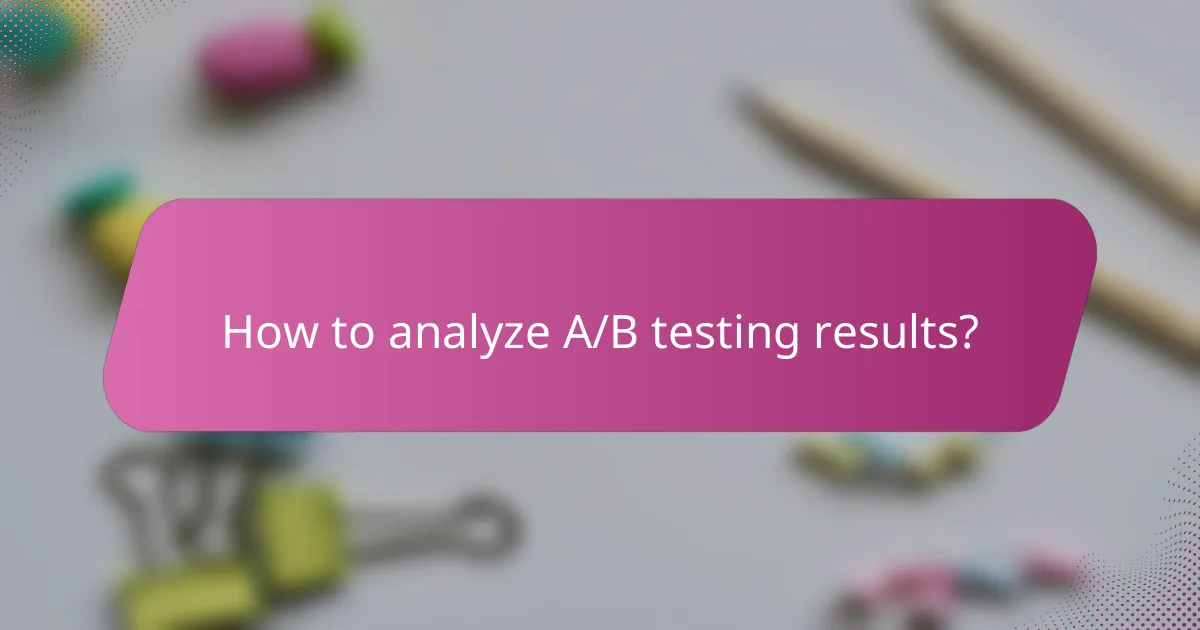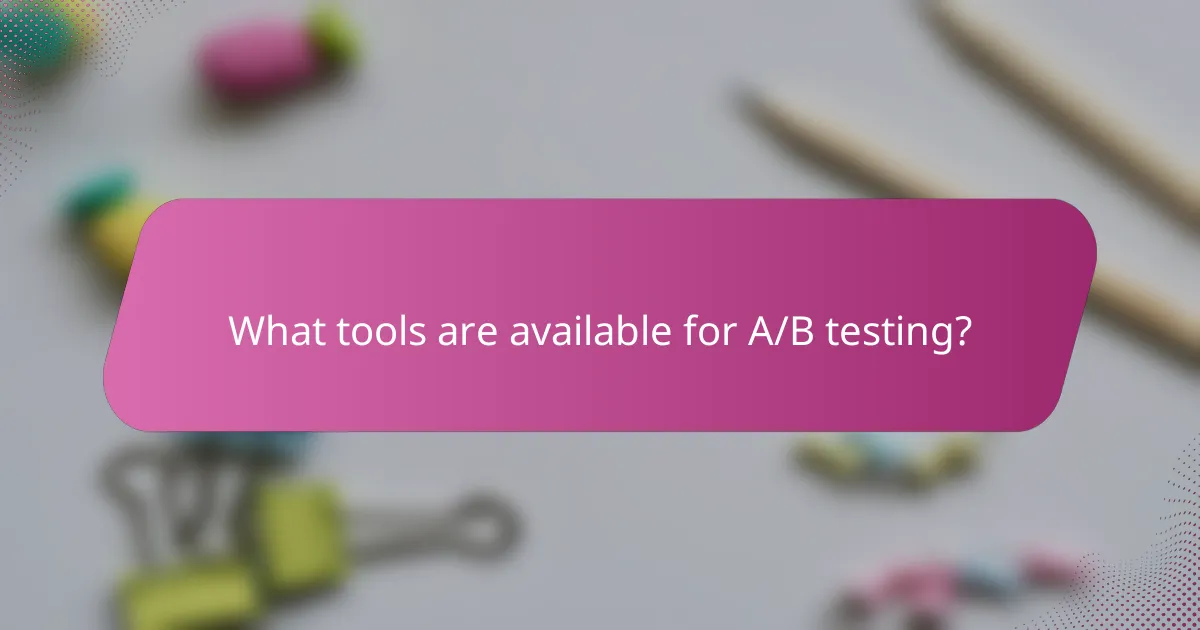A/B testing is a crucial method in display advertising that allows marketers to compare multiple ad variations to identify the most effective one. By analyzing key performance metrics such as click-through rate, conversion rate, and return on ad spend, businesses can optimize their advertising strategies. Additionally, selecting specific audience segments for testing enhances the relevance of the results, leading to more actionable insights and improved overall performance.

How to implement A/B testing in display advertising?
Implementing A/B testing in display advertising involves comparing two or more ad variations to determine which performs better. This process helps optimize ad effectiveness by analyzing user responses to different designs, messages, or placements.
Define target audience segments
Identifying target audience segments is crucial for effective A/B testing. Segments can be based on demographics, behaviors, interests, or geographic locations, allowing you to tailor ads to specific groups. For example, a clothing retailer might segment audiences by age and gender to test different styles.
Consider using tools like Google Analytics or social media insights to gather data on your audience. This information will help you create more relevant ad variations that resonate with each segment.
Create variations for testing
Creating variations for testing involves developing multiple versions of your ad to compare. Each variation should differ in one key element, such as the headline, image, or call-to-action. This focused approach allows you to pinpoint what influences user engagement.
A common practice is to create two to four variations to keep the test manageable. Ensure that each version is visually appealing and aligns with your brand identity while still allowing for meaningful comparisons.
Set performance metrics
Setting performance metrics is essential to evaluate the success of your A/B tests. Common metrics include click-through rates (CTR), conversion rates, and return on ad spend (ROAS). Choose metrics that align with your campaign goals to measure effectiveness accurately.
For instance, if your goal is to increase sales, focus on conversion rates. If brand awareness is the aim, monitor impressions and CTR. Establishing clear metrics upfront will guide your analysis and decision-making.
Analyze results for insights
Analyzing results involves comparing the performance of each ad variation against the established metrics. Look for statistically significant differences to determine which variation performed best. Tools like Google Optimize can help streamline this process.
After identifying the winning variation, consider conducting further tests to refine your approach. Continuous testing and analysis will help you adapt to changing audience preferences and improve overall ad performance over time.

What are the key performance metrics for A/B testing?
The key performance metrics for A/B testing include click-through rate (CTR), conversion rate, and return on ad spend (ROAS). These metrics help evaluate the effectiveness of different variations in an A/B test, guiding decisions for optimization.
Click-through rate (CTR)
Click-through rate (CTR) measures the percentage of users who click on a specific link or call to action compared to the total number of users who view it. A higher CTR indicates that the variation is more appealing to users. Typical CTRs can vary widely based on industry, often ranging from 1% to 5% for digital ads.
To improve CTR, focus on compelling headlines, engaging visuals, and clear calls to action. Avoid cluttered designs that can distract users. Regularly test different elements to find what resonates best with your audience.
Conversion rate
The conversion rate quantifies the percentage of users who complete a desired action, such as making a purchase or signing up for a newsletter, after clicking through. This metric is crucial as it directly reflects the effectiveness of your A/B test variations. Conversion rates can vary significantly, often falling between 2% and 10% depending on the industry and offer.
To enhance conversion rates, ensure that landing pages are optimized for user experience, with fast loading times and mobile responsiveness. A/B test different layouts, content, and offers to identify the most effective combination for your audience.
Return on ad spend (ROAS)
Return on ad spend (ROAS) measures the revenue generated for every dollar spent on advertising. This metric helps assess the financial effectiveness of your A/B test variations. A common benchmark for a healthy ROAS is around 4:1, meaning for every dollar spent, four dollars in revenue are generated.
To maximize ROAS, analyze which variations yield the highest revenue relative to ad spend. Focus on targeting the right audience and refining your ad copy and visuals. Regularly review and adjust your campaigns based on performance data to ensure optimal returns.

How to choose segments for A/B testing?
Choosing segments for A/B testing involves identifying specific groups within your audience to target with variations. This enhances the relevance of your tests and can lead to more meaningful insights and improved performance metrics.
Demographic segmentation
Demographic segmentation divides your audience based on characteristics such as age, gender, income, and education level. This approach allows you to tailor your A/B tests to resonate with specific groups, increasing the likelihood of engagement. For example, a luxury brand might target higher-income individuals while a student discount campaign would focus on younger demographics.
When implementing demographic segmentation, consider using surveys or existing customer data to gather insights. Ensure your variations appeal to the values and preferences of each demographic group to maximize effectiveness.
Behavioral segmentation
Behavioral segmentation focuses on users’ interactions with your brand, such as purchase history, website activity, and engagement levels. This method helps you understand how different behaviors influence responses to your A/B tests. For instance, frequent buyers might respond better to loyalty rewards, while first-time visitors may need more introductory offers.
Utilizing analytics tools can help identify behavioral patterns. Avoid making assumptions; instead, test variations that cater to specific behaviors to see which performs best.
Geographic segmentation
Geographic segmentation targets users based on their location, which can significantly impact preferences and behaviors. Factors like local culture, climate, and economic conditions can influence how audiences respond to your A/B tests. For example, a clothing retailer might promote winter apparel in colder regions while focusing on summer styles in warmer areas.
When segmenting geographically, consider local languages, currencies, and cultural nuances. Tailoring your messaging to reflect local trends can enhance relevance and drive better results in your A/B testing efforts.

What variations can be tested in A/B testing?
A/B testing allows marketers to evaluate different variations of a webpage or ad to determine which performs better. Common variations include changes to ad copy, visual design, and call-to-action elements.
Ad copy variations
Ad copy variations focus on altering the text used in advertisements to see which resonates more with the target audience. This can include changes in tone, messaging, or specific phrases. For instance, testing a more formal tone against a casual one can reveal which style drives higher engagement.
When creating ad copy variations, consider using A/B testing tools that allow for easy tracking of performance metrics such as click-through rates and conversion rates. Aim for a few key variations to avoid overwhelming your audience and complicating analysis.
Visual design variations
Visual design variations involve changing elements like colors, images, layout, and overall aesthetics of a webpage or ad. For example, testing a bright color scheme against a muted one can help determine which attracts more attention. Visual elements significantly impact user experience and can influence conversion rates.
To effectively test visual design, ensure that variations are distinct enough to provide clear insights. Use tools that allow for easy comparison of user interactions, such as heatmaps, to understand how design influences behavior.
Call-to-action variations
Call-to-action (CTA) variations focus on the prompts that encourage users to take specific actions, such as “Buy Now” versus “Learn More.” The wording, placement, and design of CTAs can greatly affect conversion rates. Testing different CTAs helps identify which prompts lead to the highest user engagement.
When testing CTAs, consider factors like urgency and clarity. For example, using phrases that create a sense of urgency, such as “Limited Time Offer,” may drive more immediate responses. Track performance metrics closely to determine the most effective CTAs for your audience.

What are the prerequisites for effective A/B testing?
Effective A/B testing requires a clear understanding of objectives and reliable data collection methods. These prerequisites ensure that tests yield actionable insights and lead to informed decision-making.
Clear objectives and goals
Establishing clear objectives and goals is crucial for A/B testing success. Define what you aim to achieve, such as increasing conversion rates, improving user engagement, or reducing bounce rates. Specific, measurable goals help focus the testing process and clarify what success looks like.
For example, instead of a vague goal like “improve website performance,” set a target to “increase sign-ups by 15% over the next month.” This specificity allows for better analysis of results and more effective adjustments based on findings.
Robust data collection methods
Implementing robust data collection methods is essential for gathering accurate insights during A/B testing. Use analytics tools to track user behavior, engagement metrics, and conversion rates. Ensure that data is collected consistently across all variations to maintain reliability.
Consider utilizing tools like Google Analytics or dedicated A/B testing platforms that provide detailed reports. Regularly review the data collection process to identify any inconsistencies or gaps that could skew results, and adjust accordingly to ensure high-quality data.

How to analyze A/B testing results?
Analyzing A/B testing results involves evaluating the performance of different variations to determine which one meets your objectives effectively. Key metrics such as conversion rates and user engagement help in assessing statistical significance and comparing variations.
Statistical significance
Statistical significance indicates whether the results observed in an A/B test are likely due to chance or reflect true differences between variations. A common threshold for significance is a p-value of less than 0.05, suggesting that there is less than a 5% probability that the observed differences are random.
To ensure reliable results, consider the sample size and duration of the test. Larger sample sizes typically yield more accurate insights, while tests running for at least one to two weeks help account for variations in user behavior over time.
Comparative analysis of variations
Comparative analysis involves examining the performance of each variation against predefined metrics, such as click-through rates or revenue per visitor. This helps identify which version resonates better with your audience and meets your goals more effectively.
Utilize visual tools like graphs or charts to illustrate performance differences clearly. For instance, if Variation A shows a 20% higher conversion rate than Variation B, this visual representation can quickly convey the effectiveness of each option. Always document the results and insights for future reference and continuous improvement.

What tools are available for A/B testing?
Numerous tools exist for A/B testing, each offering unique features to help optimize website performance. Popular options include dedicated platforms and integrated solutions that cater to different business needs and budgets.
Popular A/B testing tools
Some of the most widely used A/B testing tools include Optimizely, VWO, and Google Optimize. Optimizely is known for its user-friendly interface and robust capabilities, while VWO offers a comprehensive suite of testing and optimization features. Google Optimize provides a free option, making it accessible for smaller businesses.
Key features to consider
When selecting an A/B testing tool, consider features such as ease of use, integration capabilities, and reporting functionalities. Look for tools that allow for multivariate testing and segmentation to gain deeper insights into user behavior. Additionally, ensure the tool can handle the scale of your traffic and data needs.
Cost considerations
A/B testing tools vary widely in cost, from free versions like Google Optimize to premium services that can range from hundreds to thousands of dollars per month. Evaluate your budget and the potential return on investment when choosing a tool. Many platforms offer tiered pricing based on features and traffic volume, so select one that aligns with your specific requirements.


